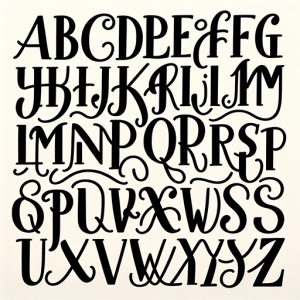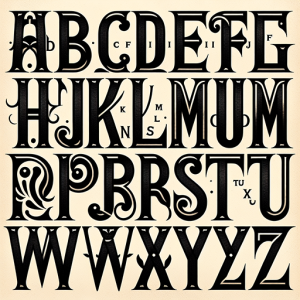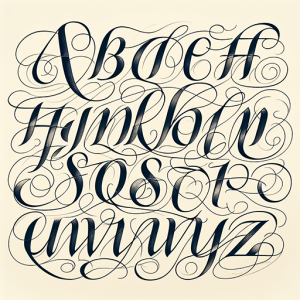PRINT - LOWERCASE
Learning print writing, which encompasses both lowercase and uppercase letters, is fundamental in English language proficiency. Uppercase letters are crucial as they highlight the beginning of sentences and proper nouns, facilitating clear understanding of sentence structures. Lowercase letters are more prevalent and vital for the readability and flow of writing. Regular practice of print writing is essential; it enhances legibility, ensuring that writings are easily decipherable. Moreover, consistent practice improves hand-eye coordination and fine motor skills, while reinforcing the retention of alphabetic and grammatical knowledge. It also helps increase writing speed and efficiency, skills that are beneficial for both academic pursuits and daily interpersonal and professional communication. Thus, fluency in print writing is key for effective written exchanges in various contexts.
Learning print writing, which encompasses both lowercase and uppercase letters, is fundamental in English language proficiency. Uppercase letters are crucial as they highlight the beginning of sentences and proper nouns, facilitating clear understanding of sentence structures. Lowercase letters are more prevalent and vital for the readability and flow of writing. Regular practice of print writing is essential; it enhances legibility, ensuring that writings are easily decipherable. Moreover, consistent practice improves hand-eye coordination and fine motor skills, while reinforcing the retention of alphabetic and grammatical knowledge. It also helps increase writing speed and efficiency, skills that are beneficial for both academic pursuits and daily interpersonal and professional communication. Thus, fluency in print writing is key for effective written exchanges in various contexts.
Learning print writing, which encompasses both lowercase and uppercase letters, is fundamental in English language proficiency. Uppercase letters are crucial as they highlight the beginning of sentences and proper nouns, facilitating clear understanding of sentence structures. Lowercase letters are more prevalent and vital for the readability and flow of writing. Regular practice of print writing is essential; it enhances legibility, ensuring that writings are easily decipherable. Moreover, consistent practice improves hand-eye coordination and fine motor skills, while reinforcing the retention of alphabetic and grammatical knowledge. It also helps increase writing speed and efficiency, skills that are beneficial for both academic pursuits and daily interpersonal and professional communication. Thus, fluency in print writing is key for effective written exchanges in various contexts.
Learning print writing, which encompasses both lowercase and uppercase letters, is fundamental in English language proficiency. Uppercase letters are crucial as they highlight the beginning of sentences and proper nouns, facilitating clear understanding of sentence structures. Lowercase letters are more prevalent and vital for the readability and flow of writing. Regular practice of print writing is essential; it enhances legibility, ensuring that writings are easily decipherable. Moreover, consistent practice improves hand-eye coordination and fine motor skills, while reinforcing the retention of alphabetic and grammatical knowledge. It also helps increase writing speed and efficiency, skills that are beneficial for both academic pursuits and daily interpersonal and professional communication. Thus, fluency in print writing is key for effective written exchanges in various contexts.
To access valuable resources, please click on the provided link. On the resource page, you’ll find practice sheets and instructional videos that demonstrate proper letter formation, helping you to enhance your writing skills efficiently. Make sure to explore these materials to optimize your learning experience.
PRINT - UPPERCASE
Learning print writing, which encompasses both lowercase and uppercase letters, is fundamental in English language proficiency. Uppercase letters are crucial as they highlight the beginning of sentences and proper nouns, facilitating clear understanding of sentence structures. Lowercase letters are more prevalent and vital for the readability and flow of writing. Regular practice of print writing is essential; it enhances legibility, ensuring that writings are easily decipherable. Moreover, consistent practice improves hand-eye coordination and fine motor skills, while reinforcing the retention of alphabetic and grammatical knowledge. It also helps increase writing speed and efficiency, skills that are beneficial for both academic pursuits and daily interpersonal and professional communication. Thus, fluency in print writing is key for effective written exchanges in various contexts.
Learning print writing, which encompasses both lowercase and uppercase letters, is fundamental in English language proficiency. Uppercase letters are crucial as they highlight the beginning of sentences and proper nouns, facilitating clear understanding of sentence structures. Lowercase letters are more prevalent and vital for the readability and flow of writing. Regular practice of print writing is essential; it enhances legibility, ensuring that writings are easily decipherable. Moreover, consistent practice improves hand-eye coordination and fine motor skills, while reinforcing the retention of alphabetic and grammatical knowledge. It also helps increase writing speed and efficiency, skills that are beneficial for both academic pursuits and daily interpersonal and professional communication. Thus, fluency in print writing is key for effective written exchanges in various contexts.
Learning print writing, which encompasses both lowercase and uppercase letters, is fundamental in English language proficiency. Uppercase letters are crucial as they highlight the beginning of sentences and proper nouns, facilitating clear understanding of sentence structures. Lowercase letters are more prevalent and vital for the readability and flow of writing. Regular practice of print writing is essential; it enhances legibility, ensuring that writings are easily decipherable. Moreover, consistent practice improves hand-eye coordination and fine motor skills, while reinforcing the retention of alphabetic and grammatical knowledge. It also helps increase writing speed and efficiency, skills that are beneficial for both academic pursuits and daily interpersonal and professional communication. Thus, fluency in print writing is key for effective written exchanges in various contexts.
Learning print writing, which encompasses both lowercase and uppercase letters, is fundamental in English language proficiency. Uppercase letters are crucial as they highlight the beginning of sentences and proper nouns, facilitating clear understanding of sentence structures. Lowercase letters are more prevalent and vital for the readability and flow of writing. Regular practice of print writing is essential; it enhances legibility, ensuring that writings are easily decipherable. Moreover, consistent practice improves hand-eye coordination and fine motor skills, while reinforcing the retention of alphabetic and grammatical knowledge. It also helps increase writing speed and efficiency, skills that are beneficial for both academic pursuits and daily interpersonal and professional communication. Thus, fluency in print writing is key for effective written exchanges in various contexts.
To access valuable resources, please click on the provided link. On the resource page, you’ll find practice sheets and instructional videos that demonstrate proper letter formation, helping you to enhance your writing skills efficiently. Make sure to explore these materials to optimize your learning experience.
CURSIVE - LOWER CASE
Learning cursive writing is beneficial for several reasons, especially from a personal growth perspective. Firstly, cursive writing enhances fine motor skills and hand-eye coordination, as the flowing movements require precision and control. This skill can improve brain development in areas associated with thinking, language, and working memory. Cursive also fosters creativity and self-expression, allowing individuals to develop a unique handwriting style which can boost self-esteem and identity. Additionally, the practice of writing in cursive can enhance focus and mindfulness, as it requires sustained attention and patience. These cognitive and emotional benefits make cursive an invaluable tool for personal growth, helping individuals cultivate a range of skills that are beneficial both academically and in personal life endeavors.
Learning cursive writing is beneficial for several reasons, especially from a personal growth perspective. Firstly, cursive writing enhances fine motor skills and hand-eye coordination, as the flowing movements require precision and control. This skill can improve brain development in areas associated with thinking, language, and working memory. Cursive also fosters creativity and self-expression, allowing individuals to develop a unique handwriting style which can boost self-esteem and identity. Additionally, the practice of writing in cursive can enhance focus and mindfulness, as it requires sustained attention and patience. These cognitive and emotional benefits make cursive an invaluable tool for personal growth, helping individuals cultivate a range of skills that are beneficial both academically and in personal life endeavors.
Learning cursive writing is beneficial for several reasons, especially from a personal growth perspective. Firstly, cursive writing enhances fine motor skills and hand-eye coordination, as the flowing movements require precision and control. This skill can improve brain development in areas associated with thinking, language, and working memory. Cursive also fosters creativity and self-expression, allowing individuals to develop a unique handwriting style which can boost self-esteem and identity. Additionally, the practice of writing in cursive can enhance focus and mindfulness, as it requires sustained attention and patience. These cognitive and emotional benefits make cursive an invaluable tool for personal growth, helping individuals cultivate a range of skills that are beneficial both academically and in personal life endeavors.
Learning cursive writing is beneficial for several reasons, especially from a personal growth perspective. Firstly, cursive writing enhances fine motor skills and hand-eye coordination, as the flowing movements require precision and control. This skill can improve brain development in areas associated with thinking, language, and working memory. Cursive also fosters creativity and self-expression, allowing individuals to develop a unique handwriting style which can boost self-esteem and identity. Additionally, the practice of writing in cursive can enhance focus and mindfulness, as it requires sustained attention and patience. These cognitive and emotional benefits make cursive an invaluable tool for personal growth, helping individuals cultivate a range of skills that are beneficial both academically and in personal life endeavors.
To access valuable resources, please click on the provided link. On the resource page, you’ll find practice sheets and instructional videos that demonstrate proper letter formation, helping you to enhance your writing skills efficiently. Make sure to explore these materials to optimize your learning experience.
CURSIVE - UPPERCASE
Learning cursive writing is beneficial for several reasons, especially from a personal growth perspective. Firstly, cursive writing enhances fine motor skills and hand-eye coordination, as the flowing movements require precision and control. This skill can improve brain development in areas associated with thinking, language, and working memory. Cursive also fosters creativity and self-expression, allowing individuals to develop a unique handwriting style which can boost self-esteem and identity. Additionally, the practice of writing in cursive can enhance focus and mindfulness, as it requires sustained attention and patience. These cognitive and emotional benefits make cursive an invaluable tool for personal growth, helping individuals cultivate a range of skills that are beneficial both academically and in personal life endeavors.
Learning cursive writing is beneficial for several reasons, especially from a personal growth perspective. Firstly, cursive writing enhances fine motor skills and hand-eye coordination, as the flowing movements require precision and control. This skill can improve brain development in areas associated with thinking, language, and working memory. Cursive also fosters creativity and self-expression, allowing individuals to develop a unique handwriting style which can boost self-esteem and identity. Additionally, the practice of writing in cursive can enhance focus and mindfulness, as it requires sustained attention and patience. These cognitive and emotional benefits make cursive an invaluable tool for personal growth, helping individuals cultivate a range of skills that are beneficial both academically and in personal life endeavors.
Learning cursive writing is beneficial for several reasons, especially from a personal growth perspective. Firstly, cursive writing enhances fine motor skills and hand-eye coordination, as the flowing movements require precision and control. This skill can improve brain development in areas associated with thinking, language, and working memory. Cursive also fosters creativity and self-expression, allowing individuals to develop a unique handwriting style which can boost self-esteem and identity. Additionally, the practice of writing in cursive can enhance focus and mindfulness, as it requires sustained attention and patience. These cognitive and emotional benefits make cursive an invaluable tool for personal growth, helping individuals cultivate a range of skills that are beneficial both academically and in personal life endeavors.
Learning cursive writing is beneficial for several reasons, especially from a personal growth perspective. Firstly, cursive writing enhances fine motor skills and hand-eye coordination, as the flowing movements require precision and control. This skill can improve brain development in areas associated with thinking, language, and working memory. Cursive also fosters creativity and self-expression, allowing individuals to develop a unique handwriting style which can boost self-esteem and identity. Additionally, the practice of writing in cursive can enhance focus and mindfulness, as it requires sustained attention and patience. These cognitive and emotional benefits make cursive an invaluable tool for personal growth, helping individuals cultivate a range of skills that are beneficial both academically and in personal life endeavors.
To access valuable resources, please click on the provided link. On the resource page, you’ll find practice sheets and instructional videos that demonstrate proper letter formation, helping you to enhance your writing skills efficiently. Make sure to explore these materials to optimize your learning experience.
COMBINED LETTERS
After mastering individual cursive letters, combining two letters is a crucial next step in developing fluid cursive handwriting. This practice helps bridge the gap between mastering isolated letter shapes and writing full words smoothly and efficiently. By learning to connect letters, students begin to understand the flow and rhythm unique to cursive writing, which differs significantly from print. This step enhances muscle memory, allowing for faster, more automatic writing over time. It also reduces the lifting of the pen between letters, leading to improved writing speed and legibility. Ultimately, coupling letters trains the hand to move seamlessly, prepping learners for more advanced writing tasks.
After mastering individual cursive letters, combining two letters is a crucial next step in developing fluid cursive handwriting. This practice helps bridge the gap between mastering isolated letter shapes and writing full words smoothly and efficiently. By learning to connect letters, students begin to understand the flow and rhythm unique to cursive writing, which differs significantly from print. This step enhances muscle memory, allowing for faster, more automatic writing over time. It also reduces the lifting of the pen between letters, leading to improved writing speed and legibility. Ultimately, coupling letters trains the hand to move seamlessly, prepping learners for more advanced writing tasks.
After mastering individual cursive letters, combining two letters is a crucial next step in developing fluid cursive handwriting. This practice helps bridge the gap between mastering isolated letter shapes and writing full words smoothly and efficiently. By learning to connect letters, students begin to understand the flow and rhythm unique to cursive writing, which differs significantly from print. This step enhances muscle memory, allowing for faster, more automatic writing over time. It also reduces the lifting of the pen between letters, leading to improved writing speed and legibility. Ultimately, coupling letters trains the hand to move seamlessly, prepping learners for more advanced writing tasks.




